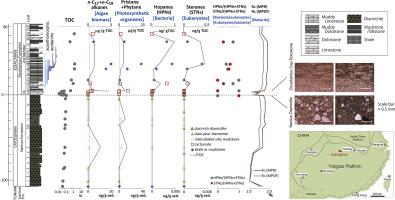Global and Planetary Change ( IF 3.9 ) Pub Date : 2021-08-08 , DOI: 10.1016/j.gloplacha.2021.103610 Atena Shizuya 1 , Kunio Kaiho 1 , Jinnan Tong 2

|
The late Neoproterozoic (645–535 Ma) represents a key geological period, when a climate shift and revolutionary biological innovations occurred during the Precambrian–Cambrian transition. The Marinoan glaciation impacted the climate and chemical composition of the oceans, restraining the evolution of early life. To elucidate evolutionary processes during the Marinoan–Ediacaran transition, this study presents biomarker evidence (molecular fossils) from the Nantuo Formation and the lower part of the Doushantuo Formation at the Jiulongwan section, China. Our results reveal possible photosynthetic activity (n-C17 + n-C19 [algae] and pristane + phytane [photosynthesis]) during the Marinoan glaciation, followed by low productivity during the early period of cap dolostone precipitation, and recovery of photosynthetic organisms (n-C17 + n-C19: from 0.00 to 0.96 μg/g TOC; pristane + phytane: from 0.00 to 3.6 μg/g TOC) or other bacteria (hopanes: from 0.00 to 0.07 ng/g TOC) during late cap carbonate deposition, with the expansion of eukaryotes (steranes/[hopanes + steranes]: from 0.0 to 0.6) after cap carbonate deposition in the early Ediacaran.


























 京公网安备 11010802027423号
京公网安备 11010802027423号